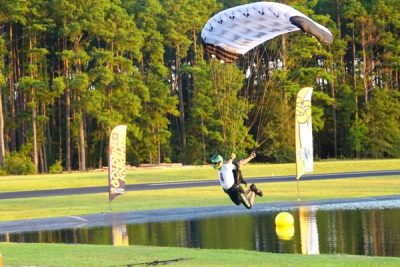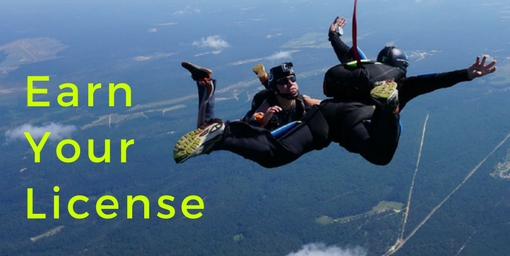
Swooping In Skydiving: What You Should Know
Monday, November 27, 2017
- Team FlyXP
- 11/27/17
- 0
- Fun Jumpers, Skydiving
Swooping–simply put, the art of piloting a fast parachute–is a discipline within skydiving that requires a towering level of commitment and training. That definition might trick you into thinking it’s a simple matter; however, you may rest assured that it’s not. Ask any experienced skydiver and they’ll trip over themselves to tell you that swooping is a huge topic.
We’ll do you a favor and avoid the technicalities of the discipline in favor of giving you a sweeping (swooping?) overview. So, without further ado: Here’s Swoop 101, so you can learn some interesting stuff about this much-beloved skydiving discipline.
1. It’s all about the parachute.
Swooping is the apex discipline within the realm of “canopy piloting,” which describes all the complex maneuvers and dynamics that a skydiver executes under his or her parachute.
Swoopers think differently than most skydivers. When you’re swooping, skydiving isn’t about freefall. It’s about the spin-tastic parachute flight, capped off by a super-fast landing with lots of acrobatic flair. When executed by skilled practitioners, swooping landings can last a very long time, with the skydiver holding themselves in a dashing pose as the ground (or water) zips along beneath their waiting feet.

2. Swooping is usually mostly freefall-free–but it’s still skydiving.
Your mental image of skydiving probably consists of a single person falling through the sky with his belly button pointed at the ground and the corners of his mouth pointing up. (One or two thumbs-up may feature prominently here.) In actuality, there are many, many ways to make a skydive–a couple of which don’t involve freefall at all.
Swooping is one of these “freefall-free” skydiving disciplines. When skydiving, swooping athletes deploy their parachutes pretty much immediately after leaving the plane. (They wait a couple of seconds to get clear and stable, then pull.)
3. Swooping definitely has its risks.
It could be compellingly argued that the only scary part of a skydive is the big, round rock underneath. The rock is a very prominent element of every skydive we’ll ever do, but it’s pretty inarguably the most prominent element of any given swooping skydive. From the low exit altitudes to the tiny, high-performance parachutes, the entire discipline is designed to send the swooper flirting heavily with the ground at a very high velocity. Skydiving swooping maneuvers feature an extraordinarily low tolerance for error.
The training required to build the necessary skills should be undertaken with great caution and pragmatism. Hopefully, that training is undertaken over a long period of time and under the watchful eye of excellent professional coaches (like those that ply their trade at Skydive Paraclete XP).

4. There’s no joy like a spectacular swooping landing–to craft oneself or to witness.
Skydive Paraclete XP even has a specialized skydiving swooping landing area–including an actual-factual “swoop pond” (which is becoming rarer and rarer on even swooping-friendly dropzones). You’re welcome to stop by on any given fair-weather weekend and watch the athletes take full advantage of it. There may even be a skydiving swooping competition on! Bring a pair of binoculars, a lawn chair and a picnic–it’s a reliably good show.
Ready to witness some of the most mind-blowing parachuting tricks you’ve ever seen?
Check out this incredible video with highlights of the 2017 Swoop Freestyle FAI World Championships in Copenhagen:
Copyright © 2024, Skydive Paraclete XP, All Rights Reserved.
DropZone Web Design & Marketing by Beyond Marketing, LLC
